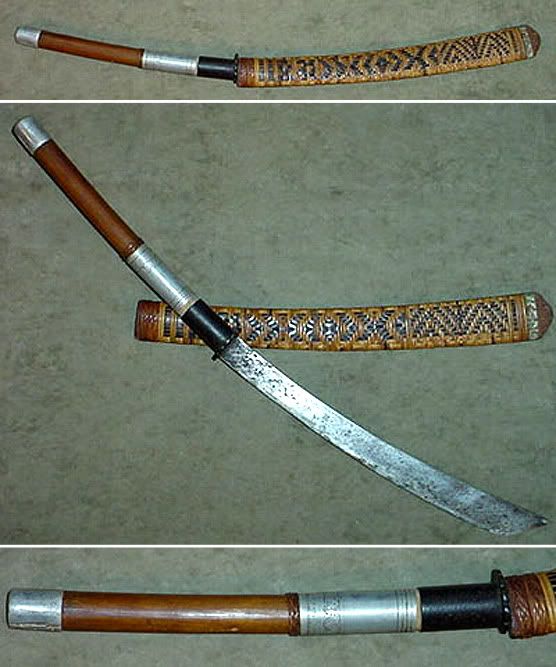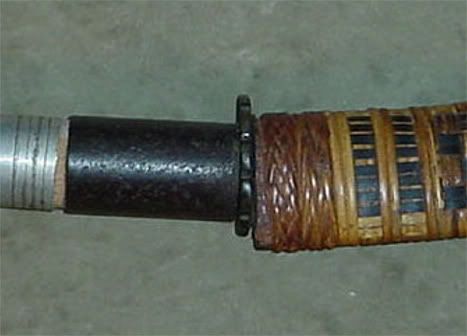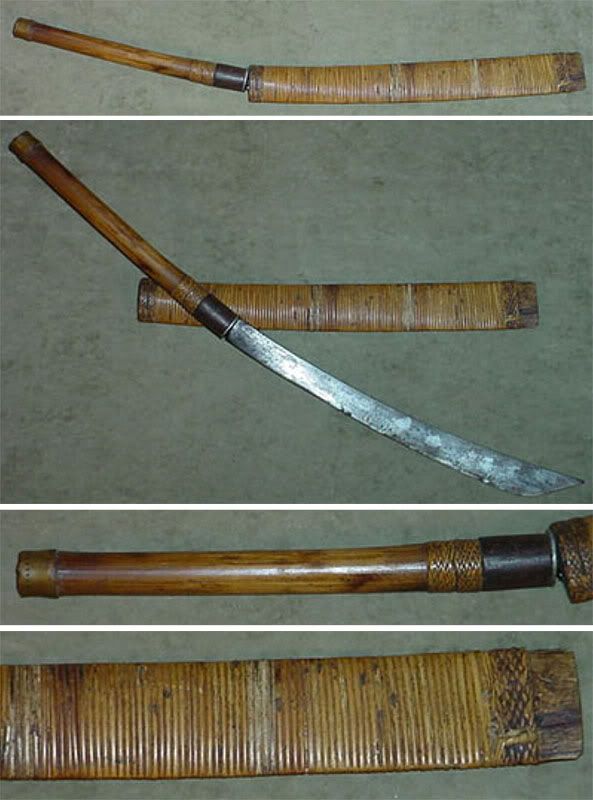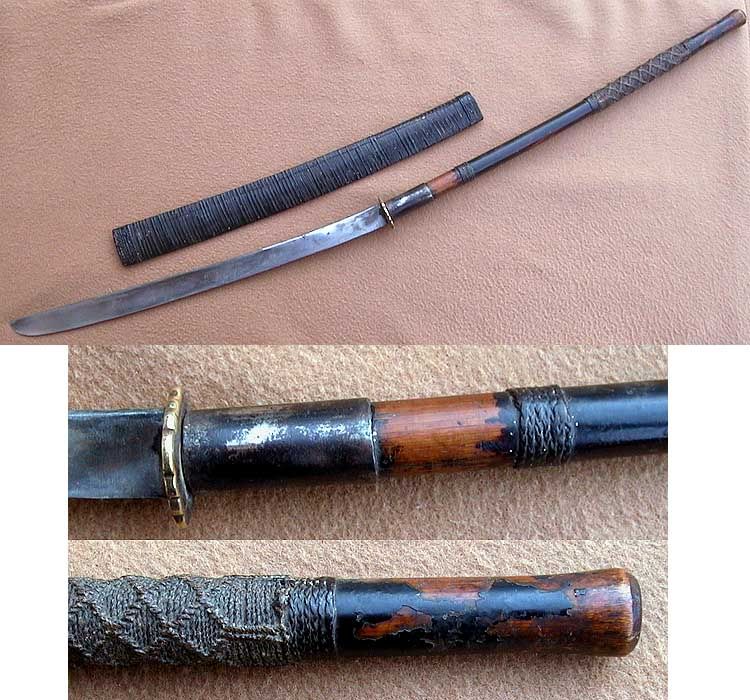
 |
|
|
#1 |
|
Member
Join Date: Mar 2005
Location: Macau
Posts: 294
|
Greetings everyone,
I'm really interested in a Montagnard Dha and I know that Andrew has posted one of his own collection. On the other hand it has been difficult to me to find one in Mark Bowditch Dha's Page Here I was wondering if some of you gentlemen could post some and also lead me to sources where I could find one. Many thanks  Antonio |
|
|

|
|
|
#2 |
|
Vikingsword Staff
Join Date: Dec 2004
Location: The Aussie Bush
Posts: 4,524
|
Antonio:
Funny you should bring this up because I made a presentation on Montagnard swords and knives at Timonium earlier this year and have been meaning to post the pictures here. I will put some up later this evening when time permits. Ian. |
|
|

|
|
|
#3 |
|
Member
Join Date: Nov 2004
Location: USA
Posts: 1,725
|
Antonio, I'm not aware of any currently offered for sale, but I picked one up from eBay, and one from Susan Stem at Tribal Trappings.
Ian's presentation was excellent. In the interim, Antonio, here are are some examples: From Oriental-Arms' sold page: http://www.oriental-arms.co.il/item.php?id=711 Here's the one I purchased from Tribal Trappings:  Andrew |
|
|

|
|
|
#4 | |
|
Member
Join Date: Mar 2005
Location: Macau
Posts: 294
|
Quote:
I was also wondering if you would consider emailing me the presentation, unless it is a Power Point. Thank you 
|
|
|
|

|
|
|
#5 | |
|
Member
Join Date: Mar 2005
Location: Macau
Posts: 294
|
Quote:
Thank you  I was wondering if it would be possible for you, not rush of course, to post the one you picked up from Ebay. I may sound sacrilegeous but I was so impressed with a that sword you have that I would appreciate some photos of the blade and the handle plus the specs. Thank you in advance.  Meanwhile my Aranyik Dha has been differentially heat treated and it is now under mounting process. Unfortunately my designer side prevails when it comes to mountings, also because the mounter is not native to rattan work. Here is the blade. I'll be doing the final polishing and etching. |
|
|
|

|
|
|
#6 | |
|
Member
Join Date: Dec 2004
Location: Virginia
Posts: 520
|
Quote:
Your blade is really looking nice, As to the mountings there are a number of options other than rattan, One that I have always liked is owned by Mark and has metal mesh on the handle  Or another idea is one on an older feeling dha  Those are just a couple, there are many more options as well |
|
|
|

|
|
|
#7 | |
|
Member
Join Date: Mar 2005
Location: Macau
Posts: 294
|
Quote:
I presume the metal mesh is much more difficult to make... Lucky Mark  Thanks. The Aranyik blade was purchased at Lung Som's. The article is here http://www.arscives.com/bladesign/visit.aranyik.htm Cheers. |
|
|
|

|
|
|
#8 |
|
Member
Join Date: Dec 2004
Posts: 987
|
Hi, Antonio! That blade is gorgeous!
I only ever had one Montagnard-style blade, but with a completely atypical the handle. I never put it on the site and now it has passed out of my hands. Andrew and Ian have some very nice ones, as you will see. The mesh on my dha's grip actually doesn't look too hard to do. Here is a close-up of another handle that uses a similar technique:  I will post some close-ups of mine as well. There are also various things that you can do with bone and ivory, but the grip would not be very good. I rather like the way shagreen is used on some Shan-style dha:  They usually have brass or copper nails holding the shagreen on, which are placed in a pattern and work rather well as finger-grips. JT (RhysMichael) has some very nice ones, of which this is my favorite:  This one is Ian's 
|
|
|

|
|
|
#9 | |
|
Member
Join Date: Mar 2005
Location: Macau
Posts: 294
|
Quote:
 I suppose you are talking about the Lung-Som blade. Had to do some changes in the shape. You know me...  Thank you for the different pictures you are posting here on Montagnard and the handles and mesh. You know I am not the best of craftsmen  But these are awesome blades!!! But these are awesome blades!!!Thank you very much my friend. Haven't heard from you. Take care and bless you. Antonio |
|
|
|

|
|
|
#10 |
|
Member
Join Date: Dec 2004
Posts: 987
|
Here are close-ups of the mesh handles, showing a few different ways of making the pattern. The first is a close-up of the handle of my dha which RysMichael had originally posted. The second is from a dha essentially the same as the mesh-handled one that I previously posted. You can see three patterns of weaving, as well as the way it is finished off at the ends.
|
|
|

|
|
|
#11 |
|
Member
Join Date: Dec 2004
Location: Ann Arbor, MI
Posts: 5,503
|
Here is my Montagnard
|
|
|

|
|
|
#12 |
|
Member
Join Date: Dec 2004
Location: Ann Arbor, MI
Posts: 5,503
|
And what is this?
The handle is solid turned and checkered brass. |
|
|

|
|
|
#13 | |
|
Member
Join Date: Mar 2005
Location: Macau
Posts: 294
|
Quote:
 It is quite intricade work beyond my capacity. I very much admire the ingeniosity od the mesh. Most grateful my friend. I thought from the smaller earlier picture that it would be some kind of regular ray skin type of mail, little flatterned spheres linked together in some other ingeniuous way. Grazzie tanti 
|
|
|
|

|
|
|
#14 |
|
Member
Join Date: Mar 2005
Location: Macau
Posts: 294
|
Thank you Ariel,
I see now the main differences between a Shan and a Montagnard. The first one is really like a pole arm. Amazing. Thanks very much. Best, Antonio |
|
|

|
|
|
#15 |
|
Vikingsword Staff
Join Date: Dec 2004
Location: The Aussie Bush
Posts: 4,524
|
Antonio, but I have been dealing with cross-platform issues between graphics in PowerPoint for the Mac and converting images to reasonably-sized JPEG images.
Here are several examples of swords of Les Montagnards (Fr. "mountain people"), and I have tribal atributions, as best I can determine, for each. 1. Montagnard dha: This one is from the Jarai people who live along the Vietnamese-Lao border:   2. Montagnard dha: This one is from the Rhade people who also live along the Vietnamese-Lao border:  3. Montagnard dha: This one is from the Hmong, a group of Montagnard tribes who now live mainly in Laos, having largely been driven out of their Vietnamese range over the last 150 years:  Notice that the last example has a blade that resembles the "Shan" style, such as commonly seen in the northern areas of Thailand and Cambodia, which are neighbors of Laos. The "Shan" style of blade suggests a western or southern Lao influence. Examples (1) and (2) above have a different style of blade with a sharply angled, wide tip that is reminiscent of certain types of Vietnamese and Chinese pole arms. Indeed, I believe that some Montagnard dha are modeled after such pole arms, which can probably all be traced to earlier Chinense weapons. It is noteworthy that the tribes to which these swords are attributed have some of their range within modern day Vietnam and some in neighboring Laos and Combodia. As a generalization, it seems that sword blade shapes alter among the Montagnard groups as one moves west and south away from the main mountainous homeland areas along the Vietnames-Lao border. There may also be other subtle regional differences: it seems that the ratio of handle to blade length increases as one goes west towards northern Thailand. That may not be surprising, because Thai swords do tend to have longer handles than, say, Burmese dha, especially those employed by the Thai cavalry in the 18th and 19th C. Also, there is a tendency for the handles on Montagnard swords to be angled upwards, away from the cutting edge, while the blades themselves are straight or slightly curved along the spine. This is a common feature of Cambodian swords, rarely so among Thai or Vietnamese swords. What I think we can say with some confidence about Montagnard swords are that they have been heavily influenced by styles to the east and north (Vietnam and China) and to the west and south (Thailand and Cambodia). Within the various tribal mountain groups, there has been a diffusion and mixing of styles, with perhaps some regional variations still discernible. This would make a nice research project for a young scholar -- got anyone that you could recommend, Antonio.  There is a lot of information posted by other members in this thread, and I do want to respond to your pictures and ideas when time permits. Ian. Last edited by Ian; 19th June 2005 at 06:15 PM. |
|
|

|
|
|
#16 |
|
Member
Join Date: Mar 2005
Location: Macau
Posts: 294
|
Greetings Ian,
Yes, I was aware of the Montagnard being from "de la Montagne"  I very much like the first one and the last one. Thank you for posting them. I am begining to see that all of them have an almost polearm configuration, which makes me wonder why the need for the extra-reach. Possibly because of the steep terrain I suspect. You know, form and function... Feel no pressure. I believe Power Point from Mac is compatible with PC. I'd be happy to host a full article and build the webpage if you like. As for the young scholar... have you ever thought of locating a Thai student in the University? Thank you for your great post and pictures. 
Last edited by Ian; 23rd June 2005 at 11:27 PM. |
|
|

|
|
|
#17 |
|
Vikingsword Staff
Join Date: Dec 2004
Location: The Aussie Bush
Posts: 4,524
|
These pictures came from Artzi Yarom's web site and he generously allowed me to use them in the Timonium presentation on Montagnard dha. This is an old sword attributed by Artzi to Laos. It resembles other Montagnard pieces, although the tip of the blade is more upturned than usual. It appears to have a strong Vietnamese/Chinese influence in style.
|
|
|

|
|
|
#18 | |
|
Member
Join Date: Mar 2005
Location: Macau
Posts: 294
|
Quote:
Thanks again 
|
|
|
|

|
|
|
#19 |
|
Vikingsword Staff
Join Date: Dec 2004
Location: The Aussie Bush
Posts: 4,524
|
The problem with PowerPoint for the Mac is that it uses graphics translators not usually found on a PC (notably QuickTime), so I need to carry my Mac when giving presentations that contain graphics.
I do have a PDF version of the talk which I can share with folks (those graphics work fine) but the file is 20.5 MB in size and I only use a 56K modem at home! Ian. |
|
|

|
|
|
#20 | |
|
Member
Join Date: Mar 2005
Location: Macau
Posts: 294
|
Quote:
A CD-Rom works wonders Ian  And I have a Mac and a PC.  Need my full address? I'm right now on my Mac (my wife took possession of the PC for now) . I'll ask you to check your PM in 5 minutes. |
|
|
|

|
|
|
#21 |
|
Vikingsword Staff
Join Date: Dec 2004
Location: The Aussie Bush
Posts: 4,524
|
Ariel: Your example resembles the "Hmong dha" that I posted in that the handle length is greater than the length of the blade, and the tip of the blade is rounded rather than sharply angled.
Mark: The woven wire hilts that you have shown are most likely Burmese work, rather than Thai. A while back, Dan relayed information from his Thai sources that such hilts were always Burmese and not found on Thai swords. Andrew: Your example has the shorter hilt and angled tip suggesting it is from one of the tribes along the Vietnamese-Lao border. |
|
|

|
|
|
#22 | |
|
Member
Join Date: Dec 2004
Posts: 987
|
Quote:
|
|
|
|

|
|
|
#23 |
|
Member
Join Date: Dec 2004
Location: Ann Arbor, MI
Posts: 5,503
|
Any opinions on the one I posted here (the short, brass-handled one)?
|
|
|

|
|
|
#24 |
|
Member
Join Date: Dec 2004
Posts: 987
|
This looks to me to be a variant of the contemporary Thai daab, which usually has a handle wrapped in wire, string or braided rattan. The blade profile and decoration, the spine inlay, and the scabbard tip and brass band are all very typical of this form of daab. However, the turned brass handle is something I have not seen before, including the form of the pommel. Perhaps it is a later upgrade or a custom piece?
|
|
|

|
 |
|
|